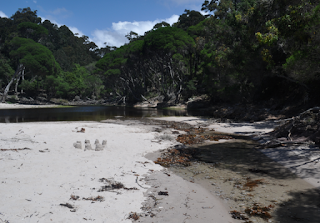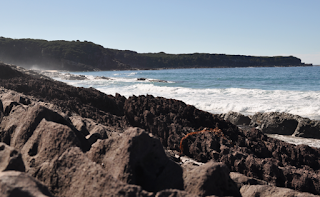After some showers of rain last night we woke to a cleansed
but sunny world and drove down towards Green Cape to begin to explore the coast
from there upwards.
Once we entered the southern section of Ben Boyd National
Park, our first stop was a lookout over Disaster Bay with sweeping views beyond
the state border. Further along we suddenly emerged from forest into open
countryside, crowded with the remains of low coastal scrub which had been
decimated by a less recent fire, but understoried by healthier coastal heath
featuring bright red bell shaped flowers.
The Green Cape Lighthouse complex was now accessed via a 200
metre steel pathway with no access to any of the buildings, but taking us to a
lookout on the end of a narrow point. As expected, the coast here was fractured
and rugged and the views were extensive both up and down the coast, as this
Cape juts out further than most.
Next we took the rougher road out to Pulpit Rock and had a
wonderful time climbing down and across a large rock platform to explore the
formations on either side – sheer cliffs backing Pulpit Rock (which was
isolated by a deep channel and provided a safeish resting place for seabirds)
on one side and another straight sided narrow promontory of rock on the other –
and waves crashing against the platform and sending up huge blowhole- like
plumes of white spray. Back at the car park we startled a Goanna and it quickly
scrambled up a tree and then, as we drove to the turn-off to City Rock, we
almost side-swiped a large grey kangaroo.
City Rock proved to be a fairly uninteresting jumble of
squarish boulders on a rock platform on the edge of Disaster Bay, but the 4WD
track in was enjoyable and the 500 metre return track was interesting, taking
us through burnt scrub understoried by lush new growth and enlivened by the
encountering of a black snake in a wet area at a footbridge.
After returning to the main road, another side track took us
out to Bittangabee Bay – a pretty little cove with a natural harbour (complete
with a catamaran and the intriguing remains of a building on one side, which
turned out to be the lighthouse store ruins). A short walking track took us
down onto the little beach and we could have taken another track out to the
headland at the back of the camping area, but we chose to continue on to
Saltwater Creek.
We lunched at Saltwater Creek before exploring its lovely
beach backed by a murky coloured lagoon, climbed up purple bands of rock lying
parallel to the beach, and wandered a little ways north along the Light to
Light Coastal Track, as we could see another beach to the north of us (which we
did not reach) and had better views of the lagoon.
Coming out of here, we took the rougher Duck Hole Road and
then veered off it onto a 4WD track (Saltwater Creek Road) that took us over a
small rotting bridge (complete with danger tape), skirting around fallen
vegetation, straddling eroded gutters, disturbing a Lyre Bird, through narrow
closed in sections where we were bush-kissed, down into gullies and back up
again, to finally re-join the tarred Edom Road and zoom up to Boyd’s Tower.
The sight of Boyd’s Tower in the bush was still impressive
(we had been here in 2001), but I was more impressed by the ancient coastline
which featured a huge circular anticlinal fold and the red siltstone rocks
typical of this area (apparently formed from volcanic ash).
With a bit of guess work and luck we managed to locate the
4WD track to Leatherjacket Bay (once again unmarked at the beginning but
signposted with an impressive wooden National Parks sign once we had travelled
a little way along it). The Bay was a small boulder strewn inlet backed by sand
and featuring another large anticlinal fold, and we found that we could
continue 4WDing out to Mowarry Point, a little further inland from the Light to
Light walking track.
The 4WD track ended near a pretty little beach below Mowarry
Point and we had to walk the final 500 metres onto the Point, where we found
that views were hampered by dense vegetation – so we bush-bashed our way down
onto the beach via a dry water-course and later found the official walking
track at the back of a grassy camp site. Then it was 5 km of slow 4WD back-tracking out to Edom Road
to drive south again to join the Princes Highway and zoom back to Eden.



















































